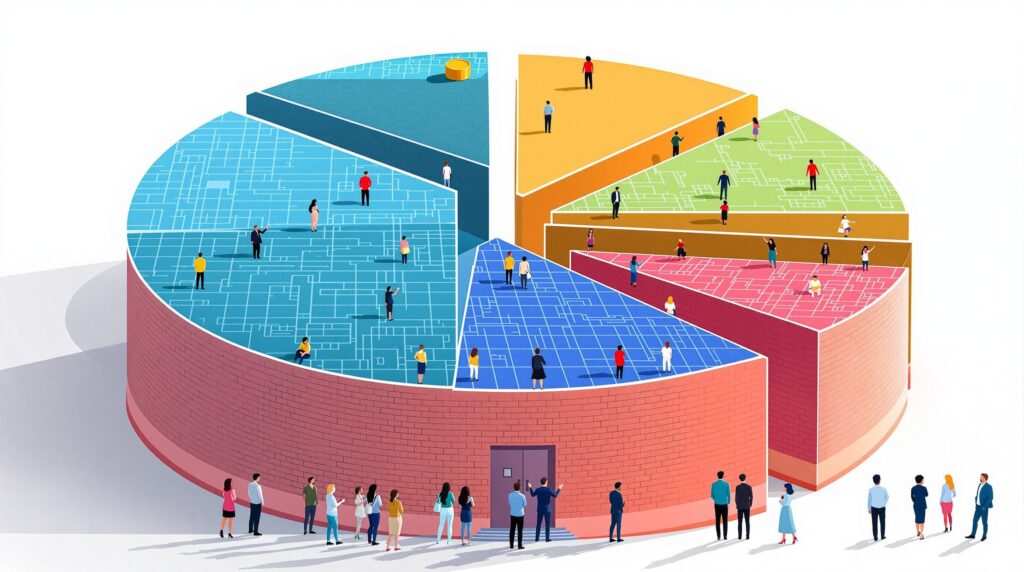[rev_slider alias=”slider-1″][/rev_slider]
The Core Structure of Layer 1 Blockchains
Layer 1 blockchains form the foundational backbone of the blockchain universe. Imagine these as the bedrock upon which the entire blockchain world rests. They are the primary framework within which all operations occur. So, what makes them distinct from other layers? Let’s delve into their key components and functionalities.
What are Layer 1 Blockchains? Layer 1 blockchains are the fundamental networks like Bitcoin and Ethereum, characterized by their decentralized security, consensus mechanisms, and ability to host smart contracts directly on their protocol.
Security and Decentralization
A critical advantage of Layer 1 systems is their robust security protocols. They employ decentralized consensus mechanisms such as Proof of Work (PoW) or Proof of Stake (PoS) to verify transactions across a distributed network. Why is this decentralization so vital? It ensures no single entity controls the network, which significantly reduces the risk of fraud or malicious attacks, creating a trustworthy ecosystem.
Native Capabilities
Unlike Layer 2 solutions that operate on top, Layer 1 blockchains have native capabilities that allow them to process transactions and execute smart contracts directly within their core structure. This means that everything required for a transaction—from validation to storage—occurs directly within the Layer 1 network. But what does this entail for scalability and efficiency? Well, primarily that the efficiency of these networks is often limited by their ability to handle large volumes of data quickly.
Why is decentralization crucial? Decentralization in Layer 1 blockchains ensures that no central authority can manipulate transaction details, making the system transparent and trustless.
Challenges with Scalability
Despite their strengths, Layer 1 blockchains often struggle with scalability issues as demand increases. Typically, these scalability challenges manifest in two primary ways:
- Transaction Throughput: High demand can clog network capacity, leading to slower transaction speeds and higher fees.
- Energy Consumption: Mechanisms like PoW consume a significant amount of energy, leading to sustainability concerns.
Many have found that innovative solutions are necessary to mitigate these issues, hence the emergence of Layer 2 solutions. But more on that later! For now, understanding the groundwork that Layer 1 networks lay is pivotal to appreciating the subsequent layers built upon them.
Is scaling a problem in blockchain technology? Yes, Layer 1 blockchains often face scalability issues, resulting in slower transaction speeds and increased costs during high demand periods.
Layer 1 blockchains are indispensable in the digital world for their fortified security, allowance for decentralized operations, and self-sufficient nature in hosting applications and validation. However, their scalability limitations necessitate complementary technologies like Layer 2 solutions to fulfill the promise of a more efficient and widespread blockchain adoption—especially critical in fast-growing markets like Africa’s digital economy. As Jara positions itself with a proprietary Layer 2 blockchain focusing on this very need, it opens new horizons for financial accessibility and economic growth across the continent.
Understanding Personal Injury Law
Have you ever wondered what happens when someone else’s negligence causes you harm? Personal injury law is here to protect you and ensure that you receive the compensation you deserve. But what does it encompass, and how can it help you during challenging times?
Did you know? Nearly 400,000 personal injury claims are filed each year in the United States.
What is Personal Injury Law?
Personal injury law, also known as tort law, allows an injured individual to go to court and seek monetary compensation for losses stemming from an accident or other incident caused by someone else’s negligence or intentional conduct.
- Torts: A legal wrong not arising from a contract.
- Negligence: Failing to act as a reasonable person would, leading to injury.
- Compensation: Money awarded to an injured party to cover costs and losses.
Types of Personal Injury Cases
Personal injury law covers a broad range of instances where someone might sustain injuries due to the actions or inactions of others. Some of the most common categories include, but are not limited to:
- Car Accidents: The leading cause of personal injury claims, often due to reckless or negligent driving.
- Medical Malpractice: Occurs when healthcare professionals fail to provide the required standard of care.
- Slip and Fall Accidents: These occur when property hazards cause someone to fall and get injured.
- Workplace Injuries: Injuries that occur in the course of employment, often covered under workers’ compensation.
- Product Liability: Comes into play when a defective product causes harm to a consumer.
Understanding Negligence in Personal Injury Law
Negligence is at the heart of most personal injury cases. But how do you determine if someone was negligent? Generally, you must prove four elements:
| Element | Description |
|---|---|
| Duty of Care: | The defendant had a legal obligation to avoid causing harm. |
| Breach of Duty: | The defendant failed to meet that obligation. |
| Causation: | The defendant’s actions directly caused the injury. |
| Damages: | The plaintiff suffered actual harm or loss. |
An injured party must prove all four elements of negligence to prevail in a personal injury lawsuit.
The Process of Filing a Personal Injury Claim
The process of filing a personal injury claim can seem daunting, but understanding the basic steps can help ease your mind. Here’s what you typically can expect:
Step-by-Step Guide
- Step 1: Seek Medical Attention: Your health is the priority. Ensure you receive the necessary treatment and obtain medical records.
- Step 2: Consultation with a Lawyer: Choose an experienced personal injury attorney who can guide you through the process.
- Step 3: Investigation: Your legal team will gather evidence, witness statements, and other relevant information.
- Step 4: Filing the Complaint: If settlement negotiations fail, your attorney will file a lawsuit on your behalf.
- Step 5: Discovery: Both parties exchange information and gather evidence through depositions, interrogatories, and subpoenas.
The Importance of Legal Representation
Choosing the right legal representation can significantly impact the outcome of your case. A proficient attorney will not only provide expert advice but also handle all legal aspects, allowing you to focus on recovery.
“Your Voice, Our Mission” – we champion your rights with the tenacity and dedication that has earned us the trust of our community members.
Why Hire a Personal Injury Attorney?
Why should you hire a personal injury attorney? It’s simple. They understand the intricacies of the law, and they know how to negotiate with insurance companies. Here’s a snapshot of what they bring to the table:
- Expert Knowledge: Attorneys are versed in legal complexities and courtroom procedures.
- Negotiation Skills: Lawyers can negotiate settlements more effectively with insurance companies.
- Trial Preparation: Should your case go to court, your attorney will meticulously prepare your case.
- Client Advocacy: An attorney provides compassionate support and aims to achieve the best possible outcome for you.
Common Myths About Personal Injury Law
There are several misconceptions surrounding personal injury claims that may deter individuals from seeking the compensation they deserve. Let’s debunk some of these myths:
Many believe that personal injury claims are drawn out and complex, but with the right guidance, they can be efficiently navigated.
Debunking Myths
- Myth 1: You can file a lawsuit anytime after the injury. Truth: Statutes of limitations restrict the time you have to initiate a legal claim.
- Myth 2: Lawyers are too expensive. Truth: Most personal injury attorneys operate on a contingency fee basis, meaning you only pay if you win.
- Myth 3: Minor injuries aren’t worth claiming. Truth: Even minor injuries can have long-term impacts and should be evaluated.
- Myth 4: Courts favor large corporations and insurance companies. Truth: A fair legal system aims to balance interests and uphold justice.
Conclusion
Understanding personal injury law is crucial in ensuring that your rights are protected and that you receive the compensation you deserve. Navigating the complexities of the legal system can be overwhelming, but with the right attorney by your side, you can focus on healing while they handle the complexities of your case. Remember, the sooner you take action, the better your chances of achieving a favorable outcome.
[rev_slider alias=”text-call-cta”][/rev_slider]
Understanding Contract Disputes
In the world of business and personal agreements, contracts are the backbone. But sometimes, things don’t go as planned. Contract disputes can arise for numerous reasons. Let’s dive into some of the most common reasons for these disputes and how they can be resolved.
Common Causes of Contract Disputes
- Misunderstandings: You’d be surprised how often contracts are disputed simply because one or both parties misunderstood the terms.
- Breach of Contract: This occurs when one party fails to fulfill their obligations as outlined in the agreement.
- Fraud or Duress: Sometimes, a contract is entered into under false pretenses or undue pressure, making the agreement voidable.
- Ambiguous Terms: Vague language can lead to different interpretations and, eventually, disputes.
- Changes in Circumstances: Unforeseen events can make it difficult or impossible to fulfill contract terms.
Steps for Resolving Contract Disputes
- Identify the Core Issue: Pinpoint exactly what the disagreement is about. Is it a term, a performance issue, or perhaps a payment problem?
- Attempt Negotiation: The first advisable step is to try and resolve the dispute through direct communication and negotiation.
- Mediation or Arbitration: If negotiations fail, consider mediation, where a neutral third party helps facilitate a resolution. Arbitration may be binding and more formal, taking the place of court proceedings.
- Legal Action: As a last resort, you might have to seek resolution through the courts, especially if the dispute involves a significant breach or loss.
Did you know? Mediation is often faster and less expensive than a lawsuit, making it a preferred option for many businesses.
The Importance of Clear Contracts
Having a well-drafted contract is vital to minimizing disputes. A clear contract should outline each party’s expectations and obligations in unambiguous terms. Here are some tips on creating contracts that stand the test of time:
Elements of a Strong Contract
- Clarity in Language: Use simple and precise language to avoid any potential ambiguities.
- Detailed Obligations: Clearly define each party’s obligations, deadlines, and milestones.
- Dispute Resolution Clause: Include a clause that specifies how disputes will be handled, ideally prescribing mediation over litigation.
- Termination Conditions: Outline scenarios under which the contract can be legally terminated by either party.
- Flexibility for Changes: Allow for amendments to be made through mutual agreement to accommodate unforeseen changes.
“A contract is only as strong as the clarity of its terms and the foresight of its drafters.” – Our Expert Legal Team
In Conclusion
When it comes to contract disputes, preparation and clear communication are the keys to avoiding headaches. But when disputes do arise, understanding the nature of the problem and knowing the available resolution pathways is vital. Remember, contracts are living documents that support your business deals – when they’re crafted with care, they’re your best defense against potential disputes.
Common Motorcycle Accident Injuries
Motorcycle accidents can result in a range of injuries, some of which are unfortunately severe due to the lack of protection compared to cars and trucks. Understanding these potential injuries can help in taking necessary precautions.
- Head Injuries: Head injuries are among the most serious consequences of motorcycle accidents, ranging from concussions to traumatic brain injuries (TBIs).
- Spinal Cord Injuries: Damage to the spinal cord can result in partial or complete paralysis, profoundly impacting the victim’s quality of life.
- Fractures: Broken bones, particularly in the arms and legs, are common due to the impact and nature of motorcycle crashes.
- Road Rash: This friction-based injury occurs when skin comes into contact with the pavement, sometimes resulting in severe abrasions.
- Internal Injuries: These can include damage to internal organs, internal bleeding, or other critical issues that might not be immediately visible.
Always wearing a helmet can reduce the risk of fatal head injuries by approximately 37% and the risk of brain injury by 67% according to the Insurance Institute for Highway Safety (IIHS).
Preventive Measures for Motorcycle Safety
While accidents can happen to anyone, adopting certain safety measures can greatly reduce the likelihood and severity of accidents:
- Wear Protective Gear: Helmets, gloves, jackets, pants, and boots provide essential protection against injuries.
- Follow Traffic Rules: Adhering to speed limits, using signals, and obeying traffic signals can help prevent accidents.
- Stay Visible: Wearing bright or reflective clothing and using your headlights during the day can make you more visible to other motorists.
- Regular Motorcycle Maintenance: Ensuring your motorcycle is in excellent working condition helps avoid unforeseen malfunctions.
- Practice Defensive Riding: Being aware of your surroundings and anticipating the actions of other drivers can help you react promptly to avoid collisions.
Understanding the Psychological Impact
Beyond physical injuries, motorcycle accidents can also cause considerable psychological impacts. These emotional and mental effects are profound and deserve attention:
- Post-Traumatic Stress Disorder (PTSD): Survivors often experience PTSD, characterized by flashbacks, nightmares, and severe anxiety.
- Depression: The aftermath of an accident might lead to depression, affecting one’s overall well-being and recovery process.
- Anxiety: Many survivors encounter anxiety when considering getting back on a motorcycle or even in everyday situations.
Addressing both the physical and psychological aftermath of motorcycle accidents is crucial for comprehensive recovery.
Frequently Asked Questions about Motorcycle Accidents
Here are some common questions potential clients may have regarding motorcycle accidents:
What Should I Do Immediately After a Motorcycle Accident?
First, ensure your safety and check for injuries. If you are able, move out of the roadway to a safe location. Call 911 to report the accident. Document the scene with photos and gather contact information from witnesses.
How Is Fault Determined in a Motorcycle Accident?
Fault is typically determined by examining evidence from the accident scene, witness testimonies, and police reports. Understanding traffic laws and reconstructing the accident timeline also play significant roles.
Can I Recover Damages if I Wasn’t Wearing a Helmet?
This depends on state laws and the specifics of the accident. While not wearing a helmet might affect the compensation you receive, you may still recover damages for injuries not related to head trauma.
What Compensation Can I Claim?
Compensation can cover medical bills, rehabilitation costs, lost wages, pain and suffering, and more. The exact damages depend on the accident’s details and the injuries sustained.
Understanding your rights and options for compensation can make a significant difference in your recovery and financial stability.
Final Thoughts on Motorcycle Accidents
Motorcycle accidents can drastically alter your life. While physical and emotional recovery is paramount, understanding your legal rights and pursuing necessary compensation is equally important. Ensuring you have a knowledgeable and compassionate legal team on your side can make navigating the aftermath a less daunting process.
“Your Voice, Our Mission” – we champion your rights with the tenacity and dedication that has earned us the trust of our community members.
[rev_slider alias=”schedule-consultation-btn”][/rev_slider]

What is the primary difference between Layer 1 and Layer 2 blockchains?
At its core, the distinction between Layer 1 and Layer 2 blockchains revolves around their roles and functionalities. Layer 1 blockchains form the foundational architecture, offering security and decentralization. In contrast, Layer 2 solutions build on these blocks to enhance scalability and transaction speed. This synergy addresses different aspects of blockchain performance.
How do Layer 2 blockchains enhance scalability in cryptocurrency networks?
Layer 2 blockchains enhance scalability by operating off the main chain, thereby reducing congestion. They work in tandem with Layer 1 to handle more transactions simultaneously, without compromising on security or decentralization. This setup is crucial for accommodating large-scale applications and increasing the throughput of cryptocurrency networks.
Can Layer 2 solutions replace Layer 1 blockchains?
No, Layer 2 solutions complement rather than replace Layer 1 blockchains. While Layer 2 enhances speed and scalability, Layer 1 provides the foundational security and decentralization necessary for a secure blockchain. Both layers are essential for a robust and efficient blockchain ecosystem.
Why are both Layer 1 and Layer 2 solutions crucial for blockchain advancement?
The necessity of both Layer 1 and Layer 2 solutions lies in their ability to collectively address blockchain limitations. Layer 1 offers security and decentralization, while Layer 2 improves scalability and speed. Together, they enable blockchains to support more applications and users, promoting widespread blockchain adoption and technological advancement.

Related Pages
Explore additional pages that delve into various facets of blockchain technology and its applications.
Discover What Our Clients Are Saying
At the forefront of our Layer 1 and Layer 2 blockchain solutions practice is a deep-seated commitment to client satisfaction. Each case is handled with utmost care, as echoed in the appreciative feedback from those we represent.

[rev_slider alias=”slider-3″][/rev_slider]
[rev_slider alias=”slider-6″][/rev_slider]
Contact Jara for Your Blockchain Solutions
As the world of blockchain rapidly evolves, the question remains: Do we really need both Layer 1 and Layer 2 solutions? At Jara, our experienced team is poised to guide you through this intricate landscape, ensuring you make the most informed decision for your blockchain strategies.
“Your Voice, Our Mission” – we champion your blockchain ambitions with unparalleled expertise and dedication.
But don’t just take our word for it. We have received recognition from leading organizations in the field:
- Highlighted among the “Top Blockchain Innovators 2023” by Tech Innovate Awards, in recognition of our leading-edge solutions and client satisfaction.
- Listed as one of the “Best Blockchain Solutions Providers in Africa 2023” by Global Tech Insights, emphasizing our role in advancing the African blockchain ecosystem.
- Featured in “Top 100 Fastest Growing Blockchain Companies 2023” by Blockchain Growth Forum, showcasing our rapid advancement and innovative technologies.
- Recognized as part of the “Sustainable Tech Leaders 2023” by EcoTech Awards, for our contribution to sustainable blockchain technology.
- Named among the “Leading Digital Finance Innovators 2023” by Financial Innovation Network, honoring our cutting-edge financial solutions.
Ready to take your blockchain initiatives to the next level? Reach out to us today at [email protected] or download the Jara app for Android or iPhone to explore how we can help you bridge global capital to African assets.
Chinyere “Chi” Nnadi Bio
Founder and CEO, Jara | Blockchain Technology Specialist
Content Reviewed by Chi Nnadi and his Content Team. Chi is an experienced entrepreneur dedicated to transforming Africa’s financial ecosystem through blockchain technology. As Founder and CEO of Jara, he builds enterprise-grade infrastructure converting illiquid African assets into globally accessible digital tokens. With his proprietary Layer-2 blockchain technology, Chi bridges the gap between global investors and Africa’s growing digital asset market.
Our Content Review Process
Chi Nnadi along with Jara’s dedicated content team, pledge to offer top-notch material. Our content guidelines ensure thoroughness, reputable sources, unbiased scrutiny, among other quality metrics. Please let us know if there is anything you believe to be inaccurate.
















